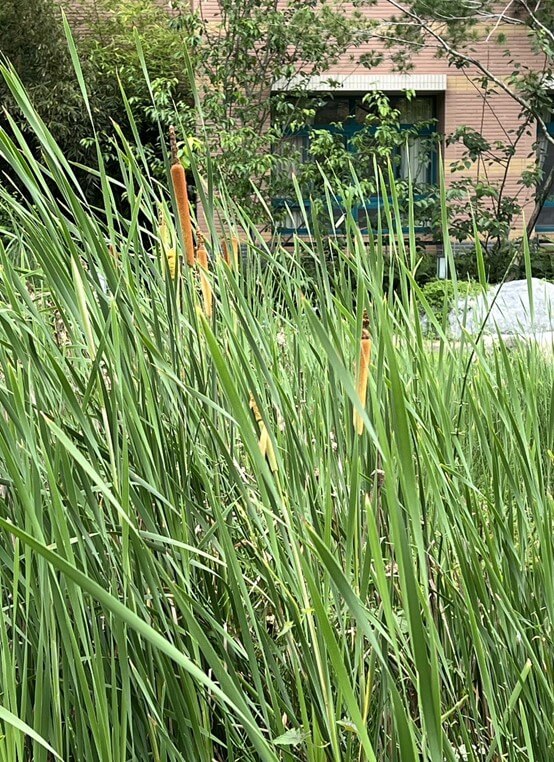魚兒魚兒水中游
——《詩經》裡的生態池
朱嘉雯
Fishes Swim in the Water: An Ecological Pond in the Book of Odes and Hymns
By Chu Chia-Wen
 蒲草
蒲草
大家還記得動畫電影「海底總動員」裡的可愛主人公小丑魚尼莫吧?牠依偎在柔軟Q彈如果凍般的海葵叢中,這畫面真讓人感到溫馨甜蜜!事實上,海葵的觸手含有劇毒!但小丑魚的表層卻擁有黏膜可以保護自己,不被海葵所蜇傷。而且小丑魚爸爸、魚媽媽,以及他們所生下的魚寶寶們,總是在海葵所構成的溫暖家裡自由自在地嬉戲,這樣一來,無意中便將海葵的天敵蝴蝶魚給趕走了,於是海葵得到了最佳的保鏢。不僅如此,小丑魚的排泄物裡還有豐富的銨元素,能夠促進海葵的生長,而海葵的觸手在水裡飄來飄去,也加速了水循環,這樣也就會為小丑魚們帶來更多的氧氣。總之,小丑魚與海葵的和睦相處,反映出大自然裡許多生物之間可以共生互利的現象,很值得人類從中體會互相合作所能夠帶來的好處與優勢。
Do you still remember the adorable protagonist, Nemo, from the animated movie "Finding Nemo"? The scene that he cuddles among the soft and elastic anemones makes you feel heartwarming, doesn’t it? In reality, the tentacles of anemones contain potent toxins! However, the surface of clownfish is covered with mucus that protects them from being stung by the anemones. Moreover, the clownfish parents and their offspring play freely in the cozy home formed by the anemones, unintentionally driving away the natural enemy of the anemones, the butterflyfish. Thus, the anemones have the best bodyguards. In addition, the excrement of clownfish also contains abundant ammonium, which promotes the growth of anemones. As the tentacles of the anemones sway in the water, they also accelerate water circulation, which in turn brings more oxygen to the clownfish. In short, the harmonious relationship between clownfish and anemones reflects many symbiotic and mutually beneficial phenomena in nature, highlighting the benefits and advantages that cooperation among species can bring.
其實在中國最古老的詩歌總集《詩經》裡,早已記載魚與藻互利共生的關係。《小雅 . 魚藻》寫道:
魚在在藻,有頒其首。
王在在鎬,豈樂飲酒。
魚在在藻,有莘其尾。
王在在鎬,飲酒樂豈。
魚在在藻,依於其蒲。
王在在鎬,有那其居。
魚兒在哪兒呢?牠悠遊在輕柔飄忽的水藻裡,你看牠可愛的大頭不一會兒就鑽進了水草裡,而修長的尾巴還在水生植物間悠悠地搖擺著;我們的周王在都城鎬京,飲著美酒逍遙自在,不就像是這尾大魚徜徉在水草間嗎?這一幅悠哉自得的水中畫面,真與迪士尼動畫堪稱異曲同工呢!
In fact, in the oldest collection of Chinese poetry, the Book of Odes and Hymns, the mutually beneficial relationship between fish and algae has long been recorded. In the poem "Fish and Algae" from the Minor Odes of the Kingdom, it said:
“Where is the fish? It leisurely swims among the gently swaying water plants.
Look at its adorable big head disappearing into the algae in a moment, while its slender tail sways gently among the aquatic plants.
Our emperor is in the capital city of Haojing, drinking fine wine and enjoying himself, just like this big fish roaming among the algae.”
This serene and contented underwater scene truly parallels Disney’s animated film, doesn't it?
而我更喜歡這首詩的第三章:「魚在在藻,依於其蒲。」詩人用了依偎的「依」這個動詞,很生動地捕捉了魚兒與水邊蒲草的相依相偎。蒲草雖然看似淡水河邊的雜草,但其實長久以來一直是人類的好幫手,因為它可以被製成繩索、草席、甚至於能用來製鞋、製船… …等等。而這麼好用的水生植物,其實是靠魚兒的排泄物,以及水中的有機物養殖而成的。那養大的蒲草,它的根又可以淨化水質,以此提供魚兒們更優質的生活環境,因此魚與蒲便形成了互利共生的生態系統。
And I like the third stanza of this poem even more. "Fish among the algae, nestled in the rushes." The poet vividly captures the intimate relationship between the fish and the rushes by using the verb "nestled". Although rushes may appear as mere weeds on the banks of freshwater rivers, they have long been valuable helpers to humans, as they can be made into ropes, mats, and even used for making shoes, boats, and more. This versatile aquatic plant actually thrives on fish excrement and organic matter in the water. The flourishing rushes, in turn, purify the water, providing the fish with a higher quality living environment. Thus, the fish and rushes form a mutually beneficial ecological system.
自唐代以來,歷經宋、元、明、清,史料都曾記載「葑田」、「架田」等桑蠶業、蔗糖業與魚塘互利的做法。魚、菜共生最大的好處是養殖魚蝦不必換水,水資源可以非常有效而穩定地被循環運用,因而形成了雙贏的生態環境。就像是《禮記 . 禮運》所描述的「大同世界」,人人互助友愛、家家樂業安居。其實這美好的境界在大自然的動、植物之間,早已實現。《詩經 . 魚藻》中,那個既天然又快樂的水底世界,真令人無比嚮往!
Since the Tang Dynasty, through the Song, Yuan, Ming, and Qing Dynasties, historical records have documented practices such as "fengtian" and "jiatian," which involve the mutual benefits of sericulture, sugarcane cultivation, and fishponds. The greatest advantage of fish and vegetable co-cultivation is that there is no need to change the water for aquaculture, allowing water resources to be efficiently and sustainably circulated. Thus, it creates a win-win ecological environment. Just like the utopia or "Great Harmony" described in the Book of Rites, where everyone helps and loves each other, and every family enjoys their work and peaceful living. In fact, this ideal state of coexistence has long been realized among the flora and fauna of nature. In the poem Fish and Algae from the Book of Odes and Hymns, that naturally joyful underwater world described truly fill


